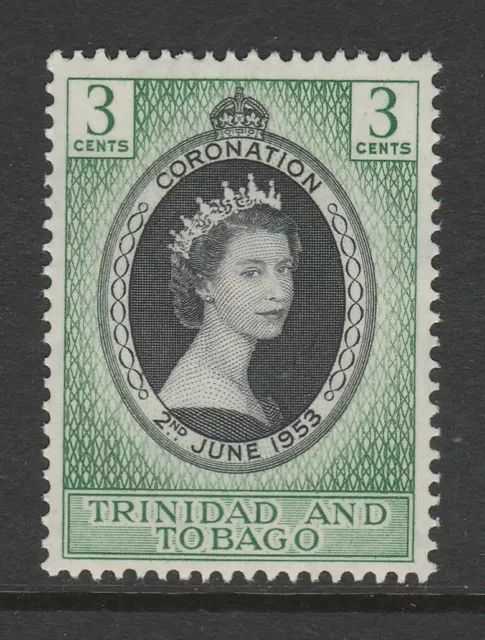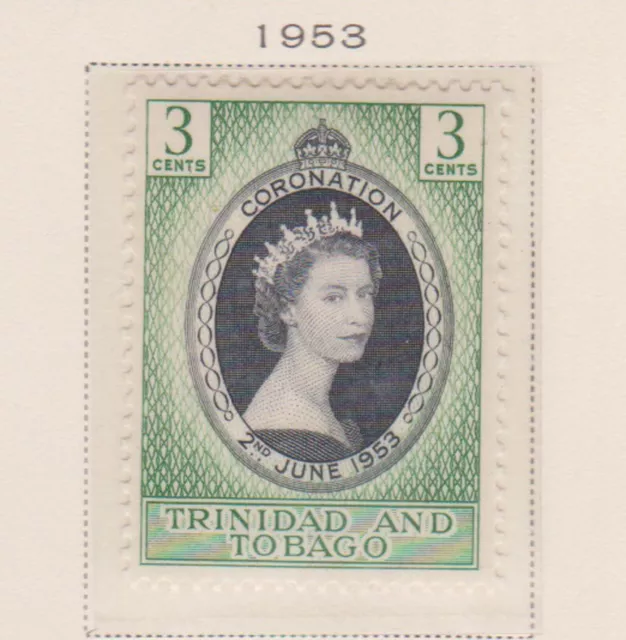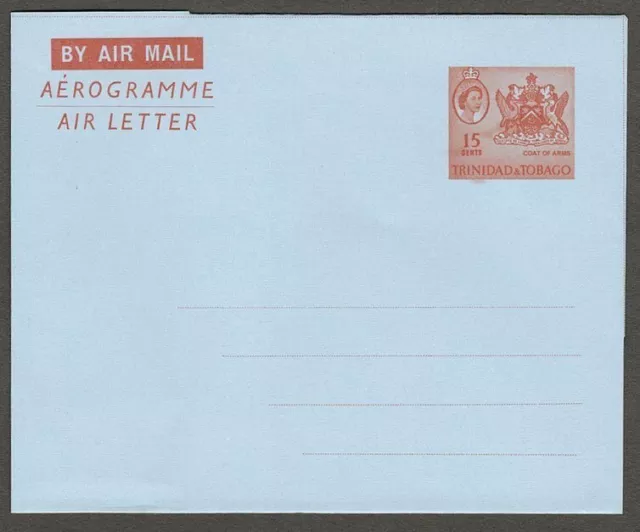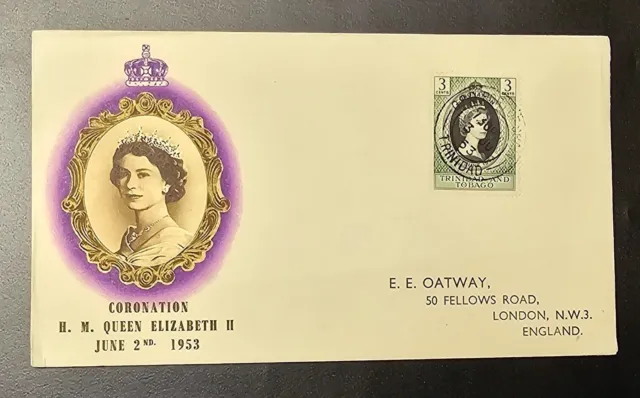TRINIDAD & TOBAGO 1953 QEII Coronation Illustrated First Day Cover Sc 84. SG 279
TRINIDAD & TOBAGO
CARIBBEAN
TRINIDAD & TOBAGO 1953 QEII Coronation on Illustrated First Day Cover Sc 84. SG 279
1953 Coronation Issue
SCOTT # 84
SG # 279
FDC COVER
Lot #119
Trinidad andTobago
Trinidad and Tobago , officially the Republic of Trinidad and Tobago ,is the southernmost island country in the Caribbean and is known for itsfossil-fuel wealth.[14] [15] Consisting of the mainislands Trinidad and Tobago , and numerous much smallerislands , it is situated 130 kilometres (81 miles) south of Grenada and 11 kilometres (6.8 miles) offthe coast of northeastern Venezuela .[16] It shares maritime boundaries with Barbados to the northeast, Grenada to the northwest and Venezuela tothe south and west.[17] [18]
The island of Trinidad was inhabited forcenturies by native Amerindian peoples before becoming a colony in the Spanish Empire , following the arrival of Christopher Columbus in1498. Spanish governor Don José María Chacón surrenderedthe island to a British fleet under the command of Sir Ralph Abercromby in 1797.[19] During the same period, theisland of Tobago changed hands among Spanish , British , French , Dutch and Courlander colonisersmore times than any other island in the Caribbean.[citationneeded ] Trinidad and Tobago were ceded toBritain in 1802 under the Treaty of Amiens as separate states and unifiedin 1889.[20] Trinidad and Tobago obtainedindependence in 1962, becoming a republic in 1976.[15] [16]
Trinidad and Tobago has the thirdhighest GDP per capita basedon purchasing powerparity (PPP) in the Americas after the United States and Canada.[21] It is recognised by the World Bank as a high-incomeeconomy .[22] Unlike most Caribbean nationsand territories, which rely heavily on tourism, the Trinidadian economy isprimarily industrial with an emphasis on petroleum and petrochemicals ;[23] much of the nation's wealth isderived from its large reserves of oil and natural gas.[24] [25]
Trinidad and Tobago is well known for itsAfrican and Indian cultures, reflected in its large and famous Carnival , Diwali , and Hosay celebrations,as well being the birthplace of steelpan , the limbo , and music styles such as calypso , soca , rapso , parang , chutney , and chutney soca .
Toponymy
Historian E. L. Joseph claimed that Trinidad'sAmerindian name was Cairi or "Land of the Humming Bird ",derived from the Arawak name for hummingbird, ierèttê or yerettê .However, other authors dispute this etymology with some claiming that cairi doesnot mean hummingbird (tukusi or tucuchi beingsuggested as the correct word) and some claiming that kairi ,or iere , simply means island .[34] Christopher Columbus renamed it "LaIsla de la Trinidad" ("The Island of the Trinity "),fulfilling a vow made before setting out on his third voyage of exploration.[35] Tobago'scigar-like shape, or the use of tobacco by the native people, may have given itits Spanish name (cabaco , tavaco , tobacco ) andpossibly some of its other Amerindian names, such as Aloubaéra (blackconch) and Urupaina (big snail),[34] althoughthe English pronunciation is /təˈbeɪɡoʊ/ .
History Indigenous peoples
Both Trinidad and Tobago were originally settled by Amerindians whocame through South America.[16] Trinidadwas first settled by pre-agricultural Archaic people at least 7,000 years ago,making it the earliest settled part of the Caribbean.[36] Banwari Trace insouth-west Trinidad is the oldest attested archaeological site in theCaribbean, dating to about 5000 BC. Several waves of migration occurred overthe following centuries, which can be identified by differences in theirarchaeological remains.[37] Atthe time of European contact, Trinidad was occupied by various Arawakan -speakinggroups including the Nepoya and Suppoya, and Cariban -speakinggroups such as the Yao , while Tobago was occupied bythe Island Caribs and Galibi .Trinidad was known to the native peoples as "Ieri" ("Land ofthe Humming Bird ").[36]
European colonisation
Christopher Columbus was the firstEuropean to see Trinidad, on his third voyage to the Americas in 1498.[36] [38] Healso reported seeing Tobago on the distant horizon, naming it Bellaforma ,but did not land on the island.
In the 1530s Antonio de Sedeño, a Spanish soldier intent onconquering the island of Trinidad, landed on its southwest coast with a smallarmy of men, intending to subdue the Amerindian peoples of the island. Sedeñoand his men fought the native peoples on many occasions, and subsequently builta fort. The next few decades were generally spent in warfare with the nativepeoples, until in 1592, the "Cacique" (native chief) Wannawanare(also known as Guanaguanare) granted the area around modern Saint Joseph toDomingo de Vera e Ibargüen, and withdrew to another part of the island.[34] Thesettlement of San José de Oruña was later established by Antonio de Berrío on this land in 1592.[16] [36] Shortlythereafter the English sailor Sir Walter Raleigh arrived in Trinidad on22 March 1595 in search of the long-rumoured "El Dorado "("City of Gold") supposedly located in South America.[36] Heattacked San José, captured and interrogated Antonio de Berrío, and obtainedmuch information from him and from the Cacique Topiawari; Raleigh then went onhis way, and Spanish authority was restored.[40]
Meanwhile, there were numerous attempts by European powers tosettle Tobago during the 1620-40s, with the Dutch, English and Courlanders(people from the Duchy of Courland and Semigallia , now partof Latvia )all attempting to colonise the island with little success.[41] [42] From1654 the Dutch and Courlanders managed to gain a more secure foothold, laterjoined by several hundred French settlers.[41] Aplantation economy developed based on the production of sugar, indigo and rum,worked by large numbers of African slaves who soon came to vastly outnumber theEuropean colonists.[42] [41] Largenumbers of forts were constructed as Tobago became a source of contentionbetween France, Netherlands and Britain, with the island changing hands some 31times prior to 1814, a situation exacerbated by widespread piracy.[42] TheBritish managed to hold Tobago from 1762 to 1781, whereupon it was captured bythe French, who ruled until 1793 when Britain re-captured the island.[42]
The 17th century on Trinidad passed largely without majorincident, but sustained attempts by the Spaniards to control and rule over theAmerindians were often fiercely resisted.[36] In1687 the Catholic Catalan Capuchin friars weregiven responsibility for the conversions of the indigenous people of Trinidad andthe Guianas .[36] Theyfounded several missions in Trinidad, supported and richly funded by the state,which also granted encomienda right to them over the native peoples, inwhich the native peoples were forced to provide labour for the Spanish.[36] Onesuch mission was Santa Rosa de Arima, established in 1689,when Amerindians from the former encomiendas of Tacarigua and Arauca (Arouca ) were relocated further west.[citationneeded ] Escalating tensions between theSpaniards and Amerindians culminated in violence 1689, when Amerindians in theSan Rafael encomienda rebelled and killed several priests, attacked a church,and killed the Spanish governor José de León y Echales . Among those killed inthe governor's party was Juan Mazien de Sotomayor, missionary priest to theNepuyo villages of Cuara, Tacarigua and Arauca.[citationneeded ] The Spanish retaliated severely,slaughtering hundreds of native peoples in an event that became known asthe Arena massacre .[36] Asa result, continuing Spanish slave-raiding, and the devastating impact ofintroduced disease to which they had no immunity, the native population wasvirtually wiped out by the end of the following century.[43] [36]
During this period Trinidad was an island province belonging tothe Viceroyalty of New Spain , together withCentral America, present-day Mexico and the southwestern United States .[44] In1757 the capital was moved from San José de Oruña to Puerto de España(modern Port of Spain ) following several pirate attacks.[45] Howeverthe Spanish never made any concerted effort to colonise the islands; Trinidadin this period was still mostly forest, populated by a few Spaniards with ahandful of slaves and a few thousand Amerindians.[44] Indeed,the population in 1777 was only 1,400, and Spanish colonisation in Trinidadremained tenuous.[citationneeded ]
Influx of French settlers
On 1777, the captain general Luis de Unzaga 'leConciliateur', married to a French Creole, allowed free trade in Trinidad,attracting French settlers and its economy improved notably.[46] SinceTrinidad was considered underpopulated, Roume de St. Laurent, a Frenchmanliving in Grenada ,was able to obtain a Cédula de Población from theSpanish king Charles III on 4 November 1783.[47] A Cédulade Población had previously been granted in 1776 by the king, but hadnot shown results, and therefore the new Cédula was more generous.[16] Itgranted free land and tax exemption for 10 years to Roman Catholic foreignsettlers who were willing to swear allegiance to the King of Spain.[16] TheSpanish also gave many incentives to lure settlers to the island, includingexemption from taxes for ten years and land grants in accordance with the termsset out in the Cédula.[48] Theland grant was 30 fanegas (13 hectares/32 acres) for each free man, woman andchild and half of that for each slave that they brought with them. The Spanishsent a new governor, José María Chacón , to implement the terms ofthe new cédula.[47]
It was fortuitous that the Cédula was issued only a few yearsbefore the French Revolution . During that period ofupheaval, French planters with their slaves, free coloureds and mulattos fromthe neighbouring islands of Martinique , Saint Lucia , Grenada , Guadeloupe and Dominica migratedto Trinidad, where they established an agriculture-based economy (sugar andcocoa).[44] Thesenew immigrants established local communities in Blanchisseuse ,Champs Fleurs, Paramin ,[49] Cascade, Carenage and Laventille .
As a result Trinidad's population jumped to over 15,000 by theend of 1789, and by 1797 the population of Port of Spain hadincreased from under 3,000 to 10,422 in just five years, with a variedpopulation of mixed race individuals, Spaniards, Africans, French republicansoldiers, retired pirates and French nobility.[44] Thetotal population of Trinidad was 17,718, of which 2,151 were of Europeanancestry, 4,476 were "free blacks and people of colour", 10,009 wereenslaved people and 1,082 Amerindians .[citationneeded ] The sparse settlement and slow rate ofpopulation-increase during Spanish rule (and even later during British rule)made Trinidad one of the less populated colonies of the West Indies, with theleast developed plantation infrastructure.[50]
British rule
The British had begun to take a keen interest in Trinidad, andin 1797 a British force led by General Sir RalphAbercromby launched an invasion of Trinidad .[16] [51] Hissquadron sailed through the Bocas and anchored off the coast of Chaguaramas . Seriously outnumbered, Governor Chacón decided to capitulate toBritish without fighting.[51] Trinidadthus became a British crown colony , with a largely French-speakingpopulation and Spanish laws.[44] Britishrule was later formalised under the Treaty of Amiens (1802).[16] [51] Thecolony's first British governor was Thomas Picton ,however his heavy-handed approach to enforcing British authority, including theuse of torture and arbitrary arrest , led to his beingrecalled.[51]
British rule led to an influx of settlers from the UnitedKingdom and the British colonies of the Eastern Caribbean. English, Scots,Irish, German and Italian families arrived, as well as some free blacks knownas "Merikins 2who had fought for Britain in the War of 1812 andwere granted land in southern Trinidad.[52] [53] [54] UnderBritish rule, new states were created and the importation of slaves increased,however by this time support for abolitionism hadvastly increased and in England the slave trade was under attack.[50] [55] Slaverywas abolished in 1833 , after which formerslaves served an "apprenticeship " period. In 1837Daaga, a West African slave trader who had been captured by Portuguese slavers andlater rescued by the British navy, was conscripted into the local regiment.Daaga and a group of his compatriots mutinied at the barracks in St Joseph andset out eastward in an attempt to return to their homeland. The mutineers wereambushed by a militia unit just outside the town of Arima. The revolt wascrushed at the cost of some 40 dead, and Daaga and his party were laterexecuted at St Joseph.[56] Theapprenticeship system ended on 1 August 1838 with full emancipation.[16] [54] Anoverview of the populations statistics in 1838, however, clearly reveals thecontrast between Trinidad and its neighbouring islands: upon emancipation ofthe slaves in 1838, Trinidad had only 17,439 slaves, with 80% of slave ownershaving enslaved fewer than 10 people each.[57] Incontrast, at twice the size of Trinidad, Jamaica had roughly 360,000 slaves.
!!! Combined shipping !!!
How to get Combined shipping. I do offer combinedshipping for multiple purchases. To get discounted shipping for thebundle, you need to use "shopping cart" with ''requesttotal from seller'' option. Please use personal computer. If you have a smartphone or tablet, then theeBay app does not support combined shipping.
Shipping
Shipments are made from Connecticut, United States of America.
Shipped with United States Postal Service (USPS) First Class Mail.
Buyers have been satisfied with my services and responsiveness.
100% Positive Feedback
- Place of Origin: Trinidad & Tobago (until 1962)
- Color: Green
- Grade: Ungraded
- Modified Item: No
- Certification: Uncertified
- Regional Status: Colony
- Denomination: 3 CENTS
- Type: First Day Cover
- Year of Issue: 1953
- Era: Elizabeth II (1952-2022)
- Quality: Used
- Currency: Decimal
- Region: Trinidad & Tobago
- Country/Region of Manufacture: United Kingdom
- Topic: CORONATION
PicClick Insights - TRINIDAD & TOBAGO 1953 QEII Coronation Illustrated First Day Cover Sc 84. SG 279 PicClick Exclusive
- Popularity - 0 watchers, 0.0 new watchers per day, 2 days for sale on eBay. 0 sold, 1 available.
- Best Price -
- Seller - 15,269+ items sold. 0% negative feedback. Top-Rated Plus! Top-Rated Seller, 30-day return policy, ships in 1 business day with tracking.
People Also Loved PicClick Exclusive

TRINIDAD & TOBAGO 1953 CORONATION Sc 84. SG 279 CORNER BLOCK PLATE 1A & 5A MNH
$11.99 0 Bids or Buy It Now 5d 15h
Trinidad & Tobago, 1953 Qeii Coronation, First Day Cover.
$4.97 Buy It Now 18d 22h
Trinidad & Tobago 1953 QEII Coronation on BPA First Day Cover
$4.05 Buy It Now 8d 8h
Trinidad & Tobago 1953 Coronation SG 279 Mnh.
$1.23 Buy It Now 10d 5h![✔️ Trinidad & Tobago 1953 - Coronation - Sc. 84 Mnh ** [5Cw2] ✔️ Trinidad & Tobago 1953 - Coronation - Sc. 84 Mnh ** [5Cw2]](https://www.picclickimg.com/HmUAAOSwbvVljnjA/%94%EF%B8%8F-Trinidad-Tobago-1953-Coronation.webp)
✔️ Trinidad & Tobago 1953 - Coronation - Sc. 84 Mnh ** [5Cw2]
$1.00 Buy It Now 12d 22h
 (F197-60) 1953 Trinidad & Tobago 3c QEII Coronation stamp MH (BJ)
(F197-60) 1953 Trinidad & Tobago 3c QEII Coronation stamp MH (BJ)$17.78$3.91 Buy It Now or Best Offer
 Trinidad & Tobago Stamps 1953 Coronation Of Qeii Mnh - Misc24-169$3.10 Buy It Now
Trinidad & Tobago Stamps 1953 Coronation Of Qeii Mnh - Misc24-169$3.10 Buy It Now
 (AOP) Trinidad & Tobago QEII 1968 15c aerogramme Watermark "A" FDC?. HG #FG12$6.89 Buy It Now or Best Offer
(AOP) Trinidad & Tobago QEII 1968 15c aerogramme Watermark "A" FDC?. HG #FG12$6.89 Buy It Now or Best Offer
 1953-59 Trinidad & Tobago Qeii Sg#267 Mlh Og Vf First Boca$2.66 Buy It Now
1953-59 Trinidad & Tobago Qeii Sg#267 Mlh Og Vf First Boca$2.66 Buy It Now


